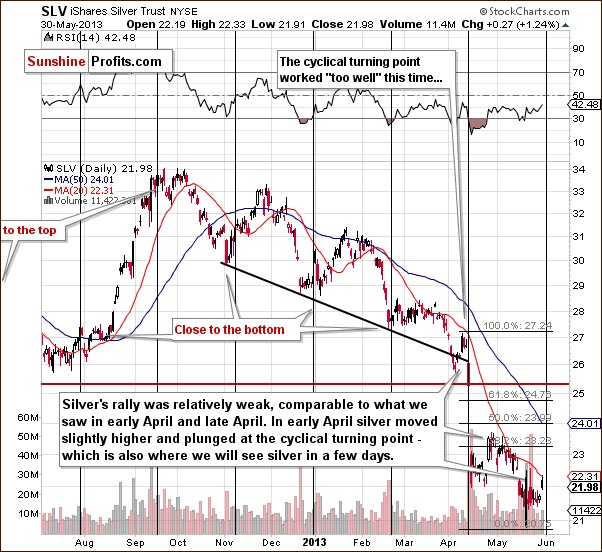Thursday's Rally In Gold And Silver Temporary Strength Or The End Of Correction?
The only thing that’s free right now is the air that we breathe. Other than that it costs to manufacture every object and commodity in the world. It takes a certain amount of money to extract a barrel of crude in Saudi Arabia, to make a car in Detroit, or produce an iPad in China.
There is also a certain cost to producing an ounce of gold. It doesn’t grow on trees. Tiny nuggets don’t rain down from the sky. It costs to explore. It costs to extract. It costs to finance loans and it costs to pay royalties. There are additional costs such as administration, equipment, environmental remedies and others. These are called the “all-in” costs.
Mines age and get depleted and extracting the gold gets more challenging and costly over time. Average grades of ore have fallen by 30% since 1999, according to GFMS, a consulting group, making it more difficult to extract gold and from ever greater depths. Finding new deposits is becoming harder. If in 2002 gold miners spent $500 million on exploration, by 2008 they were spending $3 billion, but finding much less.
So how much does it cost to make an ounce of gold today?
That is an interesting question because just like a car manufacturer will not sell a car for less than it costs to produce it, neither will mining companies sell gold for less than it takes them to extract it from the ground. And the cost of production is rising due to lower grade ore and the rise in the costs of compliance and remediation. As gold prices soared over the past decade, production costs inched higher including the prices for equipment, materials, labour and energy.
According to a recent Forbes Magazine article both Barrick Gold and Goldcorp, the largest mining companies, project that their all-in cash costs will be between $1,000 and $1,100 an ounce for 2013. In 2012, mining companies reported all-in costs such as: GG $1,082, Barrick Gold, 1,227, Yamana Gold $1,247, IAG $1377, and Agnico-Eagle, $1,343.
According to the Forbes article, a survey of 60 gold mining companies, apparently less efficient than the giants, resulted in an average production cost of $1,391. That is uncomfortably too close to where the price of gold was at the bottom this year.
Of course, it’s possible that if the price of gold were to drop, mining companies could become more efficient and thus cuts their costs and be more profitable. It makes sense that the inverse may be true as well, that as prices were rising, mining companies expanded and perhaps operated at high capacity the mines that are the most expensive to run.
World gold production is currently around 2,500 metric tons per year. The all-time high was reached in 2001, with 2,600 metric tons of gold production worldwide. It is interesting to note that production in 1900 was around 400 metric tons per year when the price per ounce was about $19 an ounce.
A Financial Times story last month says that earnings data are confirming that the decade-long expansion in the mining services industry is all but over. The reduction in mining investment is severely affecting demand for equipment such as trucks, shovels and underground machinery. Caterpillar, the world’s largest manufacturer of earthmoving equipment, has reported a 45 per cent drop in profits in the first quarter.
Does the cost per ounce of mining an ounce of gold provide a floor for the price? One can argue that theoretically the price could go lower than the cost of manufacture, but it couldn’t stay there for long. Mining companies would have no incentive to extract the gold and it would remain buried underground. They would have to cut capital spending, defer exploration and capital development programs and probably cut dividends. There would be a decline in supply and after a while, when demand would outstrip supply, the price would climb up again.
The abovementioned facts suggest that sooner or later the price of gold (and – with it – the whole precious metals sector as well) will start to rise again, to cope with the rising costs. But these facts alone cannot help us estimate the turning point itself – let us then move on to the technical part of today’s essay to see what immediate future holds for the yellow metal.
The precious metals sector moved higher on Thursday, but the question is if the move was significant enough to change the short-term outlook for gold and silver. It has been – as we wrote in our previous articles – bearish, as far as short and medium term are concerned. Let's examine the situation.
1. There was a breakout above the declining resistance line in gold and silver – however, it was invalidated on Friday.
2. The volume in GDX was significant during Thursday’s rally but it was surprisingly small in case of GLD ETF. It was average in case of the SLV ETF. Therefore, the breakout (even though it was not invalidated on Friday in case of the mining stocks) is not that reliable in our view.
3. The USD Index declined quite significantly on Thursday and yet we saw a rather average move higher in gold, so we decided to analyze the relative performance (USD - precious metals) more thoroughly. USD closed approximately at the 83 level, something it had previously done on May 10. On May 10 gold, silver and the HUI Index closed at: $1,448, $23.88 and 280, respectively. This means that mining stocks are where they were back then and gold and silver are considerably lower now. This does not bode well for the precious metals in the short and medium term.
4. We have previously mentioned the reverse parabola in the GLD to GDX ratio which meant that miners were declining more and more rapidly relative to gold. This parabola was broken on Thursday, which is a bullish sign - not a strong one, but still.
5. The move higher in silver just ahead of the cyclical turning point is actually a bearish phenomenon. If the price is to reverse its direction shortly, then if the most recent move is up, then the reversal should take the market lower. The previous cyclical turning point in silver worked in this way and it worked only too well. Silver's price plunged at the cyclical turning point after moving slightly higher - to the 20-day moving average. The chart below illustrates the situation (charts courtesy by http://stockcharts.com.)

Naturally, silver (and, naturally SLV ETF) moved lower on Friday, which may mean that the next downleg has already started.
Summing up, at this time we still think that the breakout in precious metals is not in - and that lower values of silver will be seen before the next big rally emerges. So far the USD-gold link is a strong indication against going long and we don't think that the odds for the decline have really changed. Not only have we seen a long-term breakout in the USD Index, but we also see that gold and silver are responding more significantly to dollar's rallies than to its declines.
To make sure that you are notified once the new features are implemented, and get immediate access to our free thoughts on the market, including information not available publicly, we urge you to sign up for our free gold newsletter. Sign up today and you'll also get free, 7-day access to the Premium Sections on our website, including valuable tools and charts dedicated to serious Precious Metals Investors and Traders along with our 14 best gold investment practices. It's free and you may unsubscribe at any time.
Thank you for reading. Have a great and profitable week!
About Sunshine Profits
Sunshine Profits enables anyone to forecast market changes with a level of accuracy that was once only available to closed-door institutions. It provides free trial access to its best investment tools (including lists of best gold stocks andsilver stocks), proprietary gold & silver indicators, buy & sell signals, weekly newsletter, and more. Seeing is believing.
Disclaimer
All essays, research and information found above represent analyses and opinions of Przemyslaw Radomski, CFA and Sunshine Profits' associates only. As such, it may prove wrong and be a subject to change without notice. Opinions and analyses were based on data available to authors of respective essays at the time of writing. Although the information provided above is based on careful research and sources that are believed to be accurate, Przemyslaw Radomski, CFA and his associates do not guarantee the accuracy or thoroughness of the data or information reported. The opinions published above are neither an offer nor a recommendation to purchase or sell any securities. Mr. Radomski is not a Registered Securities Advisor. By reading Przemyslaw Radomski's, CFA reports you fully agree that he will not be held responsible or liable for any decisions you make regarding any information provided in these reports. Investing, trading and speculation in any financial markets may involve high risk of loss. Przemyslaw Radomski, CFA, Sunshine Profits' employees and affiliates as well as members of their families may have a short or long position in any securities, including those mentioned in any of the reports or essays, and may make additional purchases and/or sales of those securities without notice.








